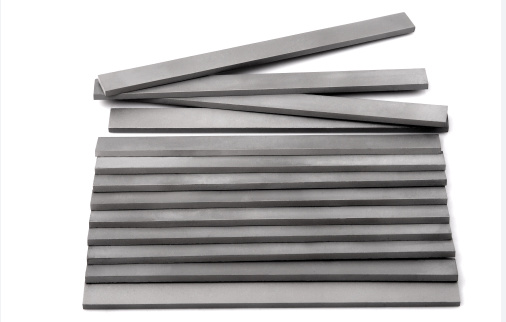카바이드 스트립은 평범하지만 강력한 소재의 리본으로, 수많은 산업 분야에서 숨은 영웅으로 활약하고 있습니다. 목공과 금속 가공에서 건설 및 제조에 이르기까지 이 다용도 스트립은 놀라운 정밀도와 효율성으로 재료를 절단, 성형 및 변형할 수 있게 해줍니다. 카바이드 스트립의 매혹적인 세계를 살펴보면서 카바이드 스트립의 특성, 용도 및 필요에 맞는 완벽한 스트립을 선택할 때 고려해야 할 주요 요소를 살펴보세요.
카바이드 스트립이란 무엇인가요?
카바이드 스트립은 뛰어난 경도와 내마모성으로 유명한 복합 소재인 초경합금의 얇고 납작한 조각입니다. 이러한 스트립은 일반적으로 극한의 경도로 알려진 화합물인 텅스텐 카바이드의 미세 입자가 바인더 역할을 하는 코발트 매트릭스에 내장된 형태로 구성됩니다.

힘의 연금술: 카바이드 스트립이 만들어지는 방법
카바이드 스트립의 탄생은 정밀 엔지니어링의 증거입니다:
- 분말 야금: 텅스텐 카바이드와 코발트의 미세 분말을 특정 비율로 정밀하게 혼합하여 원하는 특성을 얻습니다.
- 누르기 및 모양 만들기: 그런 다음 특수 금형과 고압을 사용하여 분말 혼합물을 원하는 모양으로 압착합니다.
- 소결: 압착된 스트립은 통제된 분위기에서 고온 소결 공정을 거칩니다. 소결 과정에서 코발트 바인더가 텅스텐 카바이드 입자를 녹이고 융합하여 견고하고 밀도가 높은 재료를 형성합니다.
- 마무리: 소결 후 카바이드 스트립은 원하는 표면 마감, 치수 및 특성을 얻기 위해 연삭, 연마 또는 코팅과 같은 추가 가공을 거칠 수 있습니다.
다양성의 세계: 카바이드 스트립의 종류
카바이드 스트립은 다양한 산업의 다양한 요구 사항을 충족하기 위해 다양한 등급, 크기 및 구성으로 제공됩니다:
카바이드 스트립 속성 한눈에 보기
| 속성 | 설명 | 일반적인 값 |
|---|---|---|
| 경도(HRA) | 들여쓰기 및 긁힘에 대한 내성 | 88-95 |
| 가로 파열 강도(TRS) | 굽힘 힘을 견디는 능력 | 1500-3000 N/mm² |
| 밀도 | 단위 부피당 질량 | 13.5-15.0 g/cm³ |
| 입자 크기 | 텅스텐 카바이드 입자의 크기 | 0.5-10 µm |
| 코발트 콘텐츠 | 코발트 바인더의 비율 | 6-12% |
표 1: 카바이드 스트립의 주요 속성
참고: 특정 속성 값은 카바이드 등급 및 제조업체에 따라 다를 수 있습니다.
산업 전반의 응용 분야: 카바이드 스트립이 빛을 발하는 곳
카바이드 스트립의 다재다능함은 광범위한 응용 분야에서 분명하게 드러납니다:
- 목공: 톱 팁, 라우터 비트, 목재, 합판 및 복합재 가공용 절단 도구.
- 금속 가공: 절삭 공구, 마모 부품, 금속 가공, 스탬핑 및 성형용 금형.
- 건설: 콘크리트 톱, 도로 밀링 공구, 드릴링 장비용 절삭날.
- 제조: 다양한 제조 공정을 위한 내마모성 부품, 가이드 및 툴링.
- 기타 산업: 카바이드 스트립은 항공우주에서 의료에 이르기까지 뛰어난 경도, 내마모성 및 정밀도가 가장 중요한 모든 산업 분야에서 활용됩니다.
경쟁사 비교: 카바이드 스트립 공급업체
| 공급업체 | 위치 | 가격 범위(개당) | 스페셜티 |
|---|---|---|---|
| TRUER | 글로벌 | $5 – $50 | 사용자 지정 카바이드 솔루션, 고성능 등급 |
| 케나메탈 | US | $10 – $75 | 다양한 표준 및 특수 등급 |
| 샌드빅 코로만트 | 스웨덴 | $15 – $100 | 까다로운 응용 분야를 위한 고급 코팅 및 형상 |
| Kyocera | 일본 | $8 – $60 | 절삭 공구 및 마모 부품용 고품질 카바이드 |
표 2: 카바이드 스트립 공급업체 비교
참고: 가격은 대략적인 가격이며 등급, 크기, 수량 및 시장 상황에 따라 달라질 수 있습니다.
장단점 비교: 카바이드 스트립의 장점과 한계
카바이드 스트립: 좋은 점과 좋지 않은 점
| 장점 | 제한 사항 |
|---|---|
| 탁월한 경도 및 내마모성 | 상대적으로 부서지기 쉬우며 충격에 의해 파손되기 쉽습니다. |
| 높은 절단 효율과 정밀도 | 다른 재료에 비해 비쌀 수 있습니다. |
| 긴 공구 수명, 가동 중지 시간 및 비용 절감 | 가공 및 처리를 위한 특수 장비 필요 |
| 다양한 애플리케이션과 소재를 위한 다용도성 | 모든 절단 또는 마모 용도에 적합하지 않을 수 있습니다. |
표 3: 카바이드 스트립의 장점과 한계
기본을 넘어서: 카바이드 스트립에 대한 흥미로운 사실
- 다이아몬드의 라이벌: 텅스텐 카바이드는 경도가 다이아몬드에 이어 인간에게 알려진 가장 단단한 재료 중 하나입니다.
- 전구에서 도구로: 텅스텐 카바이드의 핵심 구성 요소인 텅스텐은 처음에는 백열전구 필라멘트에 사용되었습니다.
- 우주 시대 머티리얼: 초경 소재는 극한의 특성으로 인해 로켓 노즐, 우주 탐사용 절삭 공구 등 항공우주 분야에서 사용됩니다.
카바이드 스트립 요구에 TRUER를 선택해야 하는 이유는 무엇입니까?
TRUER는 고객이 탁월한 결과를 달성할 수 있도록 카바이드 솔루션을 제공하는 데 열정을 쏟고 있습니다. TRUER가 돋보이는 이유는 다음과 같습니다:
- 타협하지 않는 품질: 당사는 최고 품질의 카바이드 소재를 조달하고 제조 공정 전반에 걸쳐 엄격한 품질 관리 조치를 취합니다.
- 맞춤형 솔루션: 당사는 등급과 형상부터 크기와 마감에 이르기까지 고객의 고유한 사양에 맞게 카바이드 스트립을 맞춤 제작하는 전문 업체입니다.
- 기술 전문성: 카바이드 전문가 팀이 전문적인 안내와 지원을 제공하여 귀사의 애플리케이션에 맞는 최적의 카바이드 솔루션을 선택할 수 있도록 도와드립니다.
- 글로벌 도달 범위: 전 세계에 진출해 있는 유니티는 전 세계 어디에서든 적시에 제품을 배송하고 신속한 고객 서비스를 제공합니다.
자주 묻는 질문: 카바이드 스트립 쿼리 해결
1. 카바이드 등급과 입자 크기의 차이점은 무엇인가요?
카바이드 등급은 텅스텐 카바이드, 코발트 및 기타 원소의 특정 배합을 의미하며 전반적인 특성에 영향을 미칩니다. 입자 크기는 카바이드 매트릭스 내의 텅스텐 카바이드 입자 크기를 의미하며 경도 및 내마모성에 영향을 미칩니다.
2. 카바이드 스트립을 연마할 수 있나요?
예, 카바이드 스트립은 특수 다이아몬드 연삭 휠과 장비를 사용하여 연마할 수 있습니다. 하지만 최적의 성능을 위해서는 올바른 각도와 간격을 유지하는 것이 중요합니다.
3. 카바이드 스트립 작업 시 안전 수칙은 무엇인가요?
카바이드 스트립은 매우 단단하여 떨어뜨리거나 잘못 다루면 부서질 수 있습니다. 카바이드 스트립을 다룰 때는 항상 보안경, 장갑, 적절한 복장을 착용하세요.
4. 내 용도에 맞는 카바이드 스트립을 선택하려면 어떻게 해야 하나요?
절단할 재료, 원하는 절단 품질, 절단 속도, 이송 속도 및 공구 수명 요구 사항을 고려하세요. 카바이드 전문가와 상담하면 최적의 선택을 하는 데 도움이 될 수 있습니다.
5. 카바이드 스트립의 수명은 어떻게 되나요?
수명은 카바이드 재종, 용도, 절삭 매개변수, 유지보수 등의 요인에 따라 달라집니다. 카바이드 스트립은 적절한 사용과 관리를 통해 공구 수명을 연장하여 가동 중단 시간과 비용을 크게 줄일 수 있습니다.




